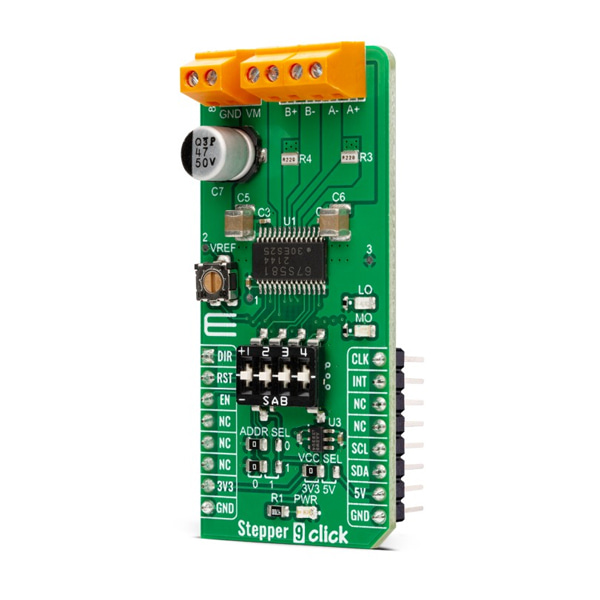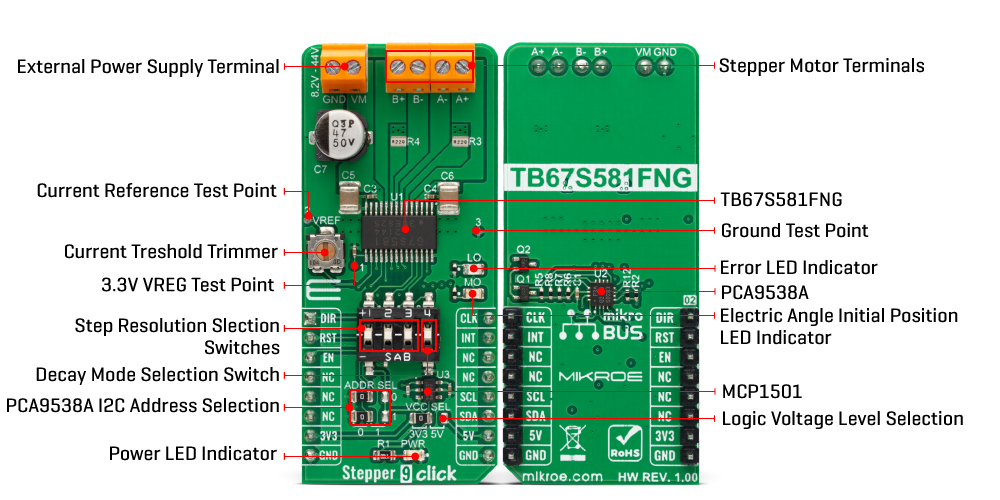2상 바이폴라 스텝 모터 드라이버 -TB67S581FNG
(STEPPER 9 CLICK)

개요
- 본 제품은 2상 바이폴라 스텝 모터 드라이버 -TB67S581FNG입니다.
- 2상 바이폴라 스텝 모터 드라이버 TB67S581FNG 칩을 기반으로 디자인된 제품입니다.
- PWM 정류 제어를 지원하며, 8.2V-44V 동작 전압 범위를 가지고 있습니다.
- 최대 2A 전류 용량을 가지고 있습니다.
특징
-
HOW DOES IT WORK?
Stepper 9 Click is based on the TB67S581FNG, a two-phase bipolar stepping motor driver designed to control one bipolar stepping motor from Toshiba Semiconductor. The TB67S581FNG supports a PWM constant-current control drive and incorporates low on-resistance DMOS FETs, delivering a 2A maximum current. It can also provide a motor output voltage rating of around 40V and has integrated protection mechanisms such as over-current, over-temperature, and under-voltage lockout for error detection (red LO LED indicator). It supports full-step to 1/32 steps resolution for less motor noise and smoother control, with a built-in regulator that allows the motor to be driven by a single power supply.

The current value in the PWM constant-current mode is set by the reference voltage obtained by the MCP1501, a high-precision voltage regulator. Also, the current threshold point of the TB67S581FNG, alongside MCP1501, can be set manually using an onboard trimmer labeled VREF. The TB67S581FNG supports various step resolution configurations through its control signals. These signals, like step resolution settings, sleep mode, or LO/MO indicators, are controlled through the PCA9538A port expander, which establishes communication with the MCU via the I2C serial interface. In addition to this digital way of setting, these functions can also be selected manually via a multifunctional switch by selecting a particular switch (1,2,3 – Step Resolution Setting; 4 - Decay Mode Control). The PCA9538A also allows choosing the least significant bit (LSB) of its I2C slave address by positioning SMD jumpers labeled as ADDR SEL to an appropriate position marked as 0 and 1, alongside its interrupt feature routed to the INT pin of the mikroBUS™ socket.
The CLK clock signal, routed to the default PWM position on the mikroBUS™ socket, shifts the current step and electrical angle of the motor with its every up-edge, while the Enable pin, labeled as EN and routed to the default CS position, controls the state of the output A and B stepping motor drive channels. Besides, all circuits can be stopped using the Sleep function and thus enable power saving mode. A simple DIR pin routed to the default AN position on the mikroBUS™ socket allows MCU to manage the direction of the stepper motor (clockwise or counterclockwise) while the RST pin initializes an electrical angle in the internal counter to set an initial position. Achieving an initial electrical angle position is indicated via onboard orange LED labeled as MO.
The Stepper 9 Click supports an external power supply for the TB67S581FNG, which can be connected to the input terminal labeled as VM and should be within the range of 8.2V to 44V, while the stepper motor coils can be connected to the terminals labeled as B+, B-, A-, and A+.
This Click board™ can operate with either 3.3V or 5V logic voltage levels selected via the VCC SEL jumper. This way, both 3.3V and 5V capable MCUs can use the communication lines properly. However, the Click board™ comes equipped with a library containing easy-to-use functions and an example code that can be used, as a reference, for further development.
SPECIFICATIONS
Type Stepper Applications Can be used for small stepping motors in various applications such as consumer electronics and industrial equipment On-board modules TB67S581FNG - two-phase bipolar stepping motor driver from Toshiba Semiconductor Key Features Low power consumption, capable of controlling one bipolar stepping motor, PWM controlled constant-current drive, operational in full, half, quarter, 1/8, 1/16, and 1/32 step resolutions, selectable decay mode, anomaly detection functions, and more Interface GPIO,I2C Compatibility mikroBUS Click board size L (57.15 x 25.4 mm) Input Voltage 3.3V or 5V